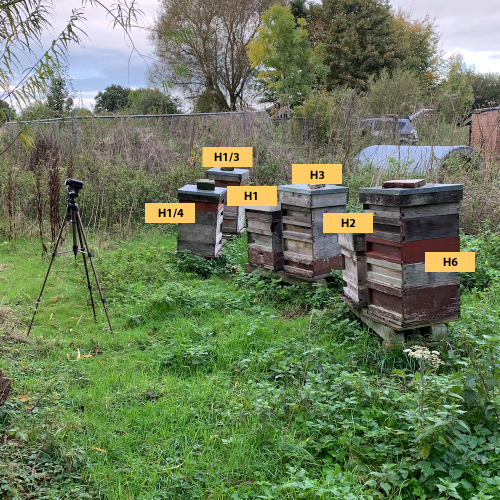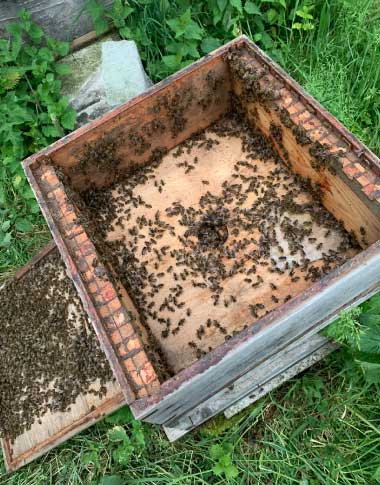Mite out - getting rid of Varroa Mites without chemicals (2019)
Going into 2019 I had ten colonies (including nucs) in my chemical free apiary.
The colony I called Hive1 turned into four colonies during 2018 and they all now have 2018 queens. The plan for those is to remove and monitor at least some of the mites during the season and to compare each for honey production.
One colony came out of the winter without a queen. (Hive six)
One of the swarm hives was very weak and has been given extra brood. (Hive five)
I took out the 'old' queen from the other swarm hive (Hive four) and moved it to the new orchard apiary. That made the bees very angry. Some of the queen cells from that hive were put on the hive that came through the winter without a queen. (Hive six)
One of Hive1's colonies has been shook swarmed and sold. (Hive one/two)
The three Hive1 2018 queened colonies remaining (at the start of May) have supers on.
The two Hive2 2018 queened colonies have supers on.
Hive2 - I have created a Hive2 2019 page here where there is a video of this year's inspections put together as one video - to see the video - click here
Hive1 I put several supers on early in the year but left it late to start hive inspections. I thought the colony needed to be left alone for a while at the start of the year. They had requeened themseves last year and the new queen I thought should be left to settle in. Here I have collected together all of my videos made of Hive1 during 2019. This is one long video of my inspections during the year, including general inspections, taking the honey crop, doing another Varroa shook swarm treatment, and feeding - going through the season from June to October - warts an all! - click here
Hive2 I have made a compilation video of hive two and made a page for it -- click here
As winter is getting nearer I did a few inspections of the usual suspects and I had a quick look at some of the hives that I have neglected over the last few months - see the video Hive inspections 22/10/2019
The hives in October 2019

17th October
Hives one and three had their feeders topped up - see video (H1)
9th October The queen removed from Hive Two with a brood box of capped brood
had a feeder put on - see video
9th October Hive Three - see video
9th October Hive Five - see video
9th October Hive One given it's third bucket of feed - see video
2nd October Hive two - the new queen seems well established. I put a super on just in case this honey to be made in the next couple of weeks. I will probably take it off again empty in three weeks time. - see video
2nd October Hive three - the floor was wrotten and had bees entering both at the front and the back - so it order to make it mouse proof I replaced the floor and at the same time replaced the brood box that was also wrotten in one corner. The procedure wasn't as traightforward as it should of been because the queen was laying above the super and as there was no brood at all under the queen excluder had been for some time.
- see video
2nd October Hive One - I removed the last frame left in from the original brood box. This was after leaving it in for 14 days. That is too long to leave it and ten days would have been better. However, the weather was not right with a steady hard rain falling most days. - see video
25th September Hive One - this was a follow up visit after removing most of the brood a week ealier. I put the super under the brood box and gave them a second feed. - see video
17 September Hive two was overdue for having it's two marked frames removed. Two frames of eggs and young lava were left in the center of the colony as a mite trap. - see video
17th September Hive one - the original experiment started with hive one September 2015 with a Varroa shook swarm on the 10th September. Now I have left it a futher week and removed the frames of brood on the 17th September. Fortunately the weather is in a warm spell. This colony has had no chemical treatment for four years and as result it had a high number of deformed wing bees in the colony. A high incidence of deformed wing virus is seen as a direct result of a high mite infestation. See video
4th September. I want to re-queen hive two with a new queen that I have bred this year and at the same time reduce the number of mites in the colony. The first stage is simple enough - remove the brood box with the queen in nd put one of it's supers on a new floor in it's place. Next satage cover the top of the super with newspaper and put a new brood box on top of the newspaper. The queen and her frames of brood can then be moved into the empty brood box - see video In order to trap the mites left (those that are on the bees and not in the capped brood) two frames of eggs and brood are returned and put in with the new queen's brood frames - see video.
4th September H1-3 general inspection
4th September H1-4 general inspection
27th August Honey taken from H2
27th August Honey taken from H3
H1 had some honey to take
H1-4 Taking off a crop of honey --- the end of the video my camera decided should be a separate video in it's own right --- watch
All colonies and nucs were inspected by the government bee inspector. The bee inspector has identified cases of EFB and one of AFB in the area. Fortunately all my colonies were clear in this apiary as far as could be seen by inspection.
H2 general inspection
H1 general inspection 2nd July
H1-4 General inspection 2nd July Eggs and brood, no signs of swarming.
H1-3 Follow up inspection - just to be sure that the new queen has united with the old colony OK. Yes all seem happy. Food gone new wax made. One frame of brood removed.This queen is from a selected line of 'gentle' bees and this colony is likely to have a few frames of brood removed before we get to the autunm.
24 june H1 The original non treatment hive is looking a bit swarmy. It now needs a full inspection next week. I put another super on in the hope that this year's summer flow will need more frames.
H3 sister of H2 First full inspection of the year. The colony still had a super under the brood box that was put there last summer with honey in it to see them through the winter. That super was empty.
Hive2 had eggs in cups and a queen cell under production today. I couldn't find the quuen to remove her - so I removed the frame with the queen cell on and two other frames of brood and two super frames of stores and put them in a polynuc that in turn I took away to another apiary.
Uniting bees Colony Hive1-3 that had the queen removed and the bees drained from it's supers didn't have any emergency queen cells. I had been feeding the bees to keep them going in what hasn't been good flying weather. Using the newsapaper method I put a brood box on top of the existing brood box with a new laying queen in it. Hopefully the bees in the bottom box will want a laying queen and won't kill her.
Checking Hive1-3 for emergency queen cells after the removal of their queen.
Inspection 13th June - Hive1-4
After three days of rain I grabbed half an hour between the showers to have a quick look inside Hive1-4 (the last of the four to be set up last year). All looked OK. I still haven't taken any honey off - so there was no risk of the bees running out of stores during the cold wet days. This hive has had no treatment at all - from setting it up last summer, no treatment in the Autumn 2018 and Winter 2018/9 and now none through the Spring 2019. The bees have been keen to make honey and given better weather I believe would have made a good spring crop for me to harvest.
Hive1-3 after the clearer board had removed the bees from the supers.

Hive1-3
I inspected the Hive1-3 colony that had a queen from selected stock. There were five supers on above the brood box and there were a few drones cells in the top supers but no worker brood. In two of the supers nearer the brood box were two frames (in separate supers) with three queen cells on each. These were removed. The queen was found and also removed. The crown board was put on top of the brood box with the feeder hole uncovered and an empty super on top of that with a clearer board between that and the supers with honey in.
Honey taken (from the hive with the queen cells) - bucket of feed put on. As I had used a clearer board over an empty super leaving the hole in the crown board fully open I expected the bees to go into the brood box again. But of course they had no queen and I found most of then on the underside of the clearer board. Which I turned upside down at the hive enrance - see photo.
On reflection I think I found these bees in the first stage of the superseedure process and they would have been quite OK if left them without an inspection at all.
Hives 2 and 3 have sister queens
First full 2019 inspection for hive 2 24th June I took out two frames from the brood box - one was a frame of drone brood - the other a frame of capped brood. I put in one blank frame and one drawn out super frame. There is honey thats needs to be taken off.
Hive1-4 First full inspection 21-5-2019 The hives have been left to get on with it to make honey this year. (Hive one/four)